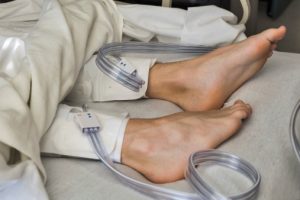 A blood clot alone can pose health risks to an individual. When a blood clot occurs, blood cannot travel through the veins to reach organs and cells. In some cases, the clot breaks free and travels throughout the circulatory system. If the clot reaches the heart is can limit or stop the amount of blood the heart receives, which is known as a pulmonary embolism.
A blood clot alone can pose health risks to an individual. When a blood clot occurs, blood cannot travel through the veins to reach organs and cells. In some cases, the clot breaks free and travels throughout the circulatory system. If the clot reaches the heart is can limit or stop the amount of blood the heart receives, which is known as a pulmonary embolism.
Deep vein thrombosis (DVT) is when a blood clot forms in one or more deep veins, commonly in the leg. Deep veins carry most of the blood in our bodies and are typically found near arteries. It’s important to prevent deep vein thrombosis as it can lead to a potentially life-threatening pulmonary embolism.
Causes of deep vein thrombosis
Advertisement
Blood clots in general can be caused by anything that prevents the blood from circulating or clotting normally. Factors that can contribute to a blood clot include:
- Laying in a bed or sitting for prolonged periods of time
- Family history
- Obesity
- Surgery
- Fractures in the pelvic or groin area
- Cancer
- Smoking
- Some autoimmune disorders
- Taking estrogen or birth control pills.
Symptoms of deep vein thrombosis
Symptoms of deep vein thrombosis include:
- Swelling of the area
- Changes in skin color
- Skin which feels warm to touch
- Pain.
Additional symptoms which may signal a pulmonary embolism are:
- Shortness of breath
- Chest pain
- Feeling lightheaded or dizzy
- Rapid pulse
- Coughing up blood.
Prevention tips for deep vein thrombosis
Blood clots are preventable with some helpful lifestyle changes. For example, always ensure you are taking medication as prescribed, especially post-surgery if you have been directed to take blood thinners. Avoid long periods of sitting or staying in bed. Even while sitting it is best to avoid crossing your legs as this limits blood flow. If you have to take a long overseas flight, ensure you take moments to stand or walk the aisles as well.
Losing weight and not smoking are also effective measures to prevent deep vein thrombosis. Lastly, exercise as it can improve the function of your heart as well as boost circulation. These tips are simple and can avoid you pain and additional medication to treat the blood clot.
Related Reading:
You should never hide this symptom from your doctor
Take a second to look at your feet and legs. How do they look? Do they appear to be swollen? If so, does this happen often? Swollen feet and legs are often overlooked as symptoms because we associate them with aging. But ignoring swelling could be detrimental to your health. Continue reading…
Next time you get blood work, ask this one question
Advertisement
Maybe you are the type of person who isn’t in a rush when it comes time to have your blood taken. You wouldn’t be alone. The idea can make the best of us a little queasy. Regardless of any fears of the needle, knowing your blood type is more important than you may realize. Continue reading…
Sources:
http://www.mayoclinic.org/diseases-conditions/deep-vein-thrombosis/basics/prevention/con-20031922
http://www.clevelandclinicmeded.com/medicalpubs/diseasemanagement/cardiology/venous-thromboembolism/Default.htm
http://www.nlm.nih.gov/medlineplus/ency/article/000156.htm
http://www.stoptheclot.org/diagnosis_symptoms/what_are_consequences_dvt.htm
